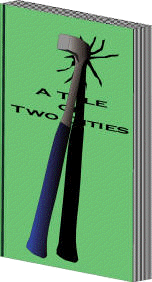Geology Through Literature:
Hans Christian Andersen's: Ole, The Tower Keeper (1859)
Ole, The Tower Keeper (1859)
Among the books I had recently lent Ole was one about pebbles, which had greatly pleased him.
"They are truly veterans from olden times, those pebbles," he said, "yet people pass them by without thinking, and trample them down in fields or on beaches, those fragments of antiquity. I have done so myself. From now on I shall hold every paving stone in high respect!...
"The romance of the Earth is truly the most fascinating of all romances. It's a shame we can't read the first parts of it; but they're written in a language we haven't learned yet; we have to dig away among strata and rocks, puzzling out bits here and there from the early acts of earth's drama.... The crust on which we move remains solid so that we never fall through, and so it is a story of millions of years, with steady progress.
"Many thanks for your book on pebbles; those old fellows could tell us so much if only they could talk.... And it makes you feel so ridiculously young, compared with the millions of years of these venerable stone!"
"...I was rolling through millions of years with my rocks, watching them break loose up in the North, drift along on icebergs ages before on a reef, and at last peer up through the water and say, 'This shall be Zealand!'..."
What Andersen is describing is exactly what geologists hope to decipher. Geologists read the rocks. They listen to what the rocks have to say and have been doing it far before Andersen's time period. Which he should be aware of with his comments about the earth being millions of years old, since geologists are the reason that we even thought that the earth was millions of years old at that time (we now know it to be ~4.543 billion years old).
 |
| Layers of the Earth |
The scientist that is often touted as the father to modern geology is James Hutton, who lived from 1726 to 1797. He is the one who came up with some of the first principles of geology, which are his way of essentially listening to what the rocks had to tell us. James Hutton's primary theory that he developed was the Principle of Uniformitarianism, which stated that the present is key to the past and that all processes happening on Earth today are the same ones that happened on the Earth in the past. This means that when we have ripples and mud cracks in modern day sediments, they can help us identify ripple marks and mud cracks in the rock record. Since everything happening today has happened in the past and erosion and deposition are incredibly slow processes then the age of the Earth must be very, very old. Although he couldn't be sure of an exact age of the Earth, one could easily assume the Earth was millions or even billions of years old based on the rates of modern day erosion and sedimentation.
His research continues today with geologists "reading the rocks" and listening to their life stories. Then taking this information and combining it with the histories of other rocks, until we have a full and complete global history dating back to the beginning of the earth. We aren't fully there yet, and we may never get fully there, but it is an ever hopeful promise that we may.
Shooting Stars
"Then three or four beautiful shooting stars fell; they shone brightly, and started my thoughts off in an entirely different direction. Does anybody know what a shooting star really is? The learned do not know!..."
Although Andersen claims that the "learned do not know", we do know today what they are. They are bits of cosmic debris that burns up when it enters our atmosphere, technically called a meteor. The meteor is the flash of light that we see when the debris enters the atmosphere and the debris itself is called a meteoroid.
 |
| Illustration of a "fireball" from a 1771 publication by Le Roy (Marvin, 2007). |
What interests me about this statement is when did scientists begin to learn about meteors and shooting stars. One of the first scientists to suggest that the fireballs were real events was Ernst Chladni in 1794. He hypothesized that shooting stars, fireballs that came crashing to earth, and the physical meteorites were all related phenomena. Although there was resistance to the idea at the time, he persevered until his death in 1827. It was not until 1834, that scientists had been able to start piecing together that meteor showers were tied to specific orbital events, and from here to realize that shooting stars were actually pieces of orbiting materials burning up in the atmosphere.
It took until 1862 when the hypothesis that shooting stars had an extraterrestrial origin had firmer proof with the prediction and the tying of comets to specific orbits and times of the year. With these observations, future meteor showers were able to be predicted including the 1866 Leonid shower. So, even though the story was written in 1859, there still was significant evidence at that point that meteoroids were the cause of the shooting stars with firmer proof only a few years away.

No comments:
Post a Comment
Due to the large number of spam comment (i.e. pretty much all of them). I have turned off commenting. If you have any constructive comments you would like to make please direct them at my Twitter handle @Jazinator. I apologize for the inconvenience.
Note: Only a member of this blog may post a comment.